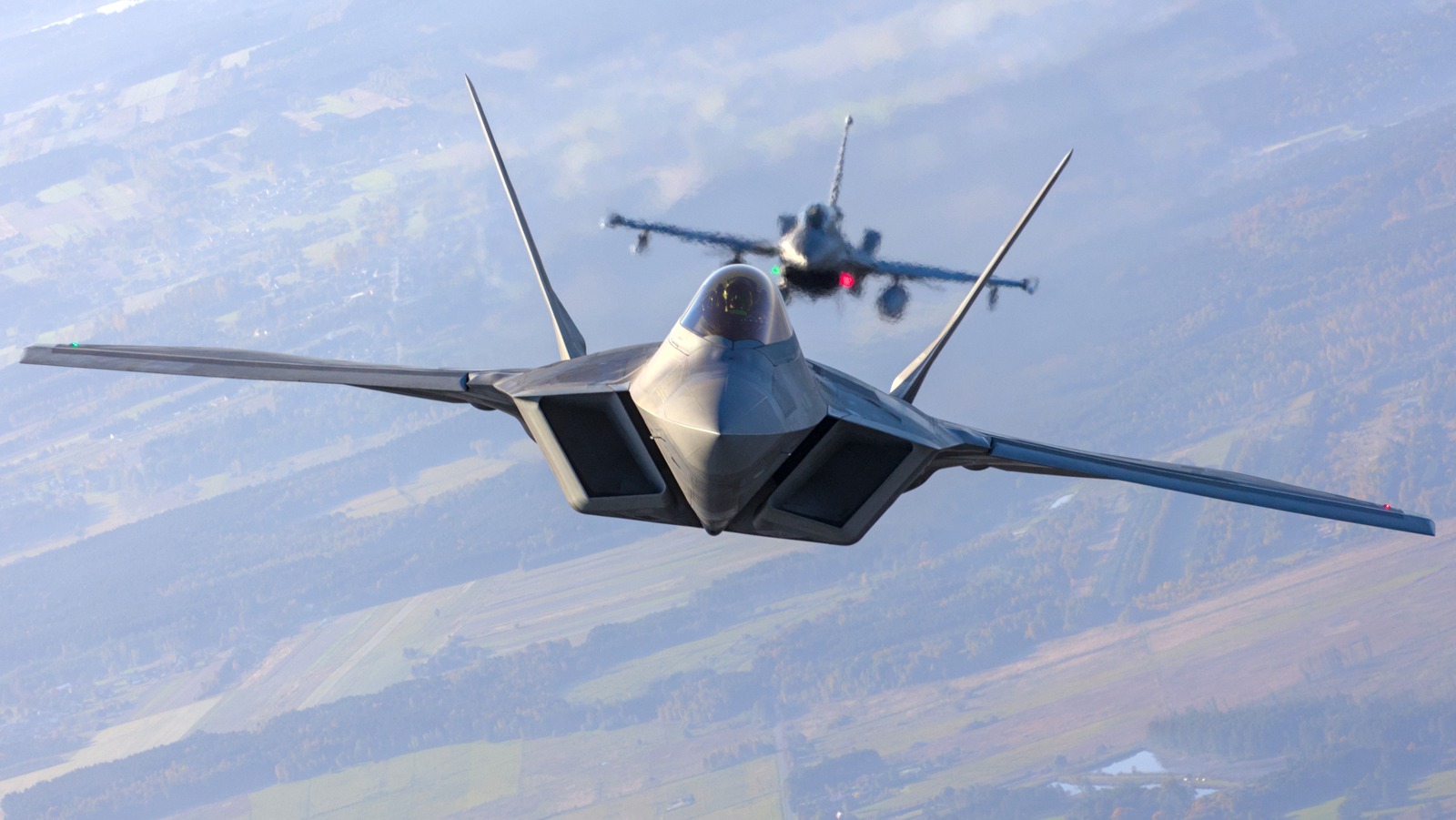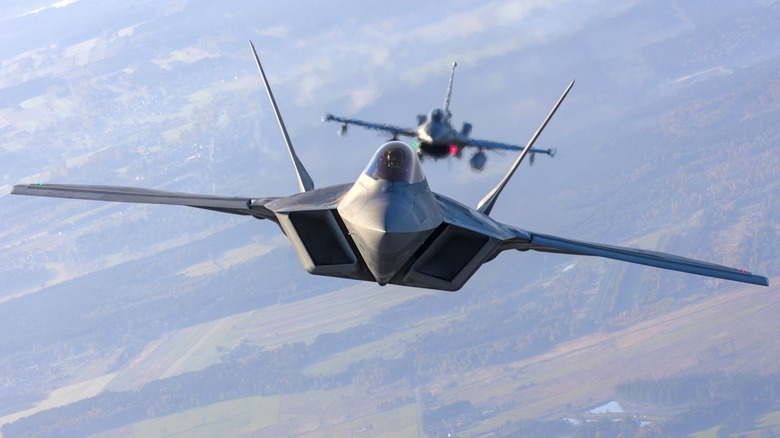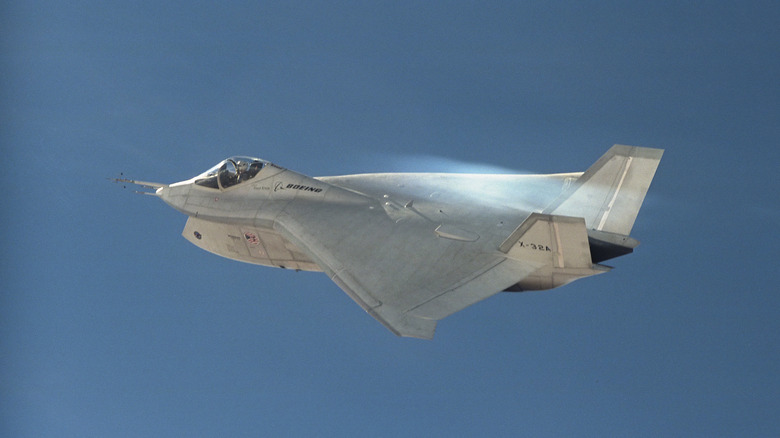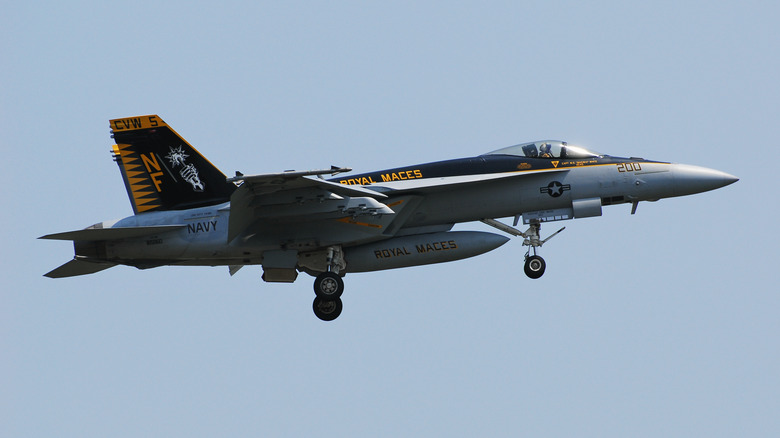
The Best And Worst Fighter Aircraft Boeing Has Ever Made

Boeing is one of the leading names in the world of aviation but it is a company that is best known for its passenger jets rather than military aircraft. After all, its most famous and best Boeing jets include the likes of the 747, 777, and 787 Dreamliner. But the company has a long history as a military contractor, supplying fighters, bombers, and other types of aircraft to the U.S. military and its allies around the world.
Advertisement
Although it doesn't have many current fighters in the mix, Boeing has produced many different fighters over the years, ranging from early biplanes to modern supersonic jets. Here we are going to look at some of the best and worst fighters that Boeing has produced, ranking them by examining their overall reception, expert opinion, and how many were put into service. You might even be surprised by a few names that Boeing was actually involved in making.
Boeing XF8B
The Boeing XF8B, also known as the Model 400, is a World War II-era aircraft. The reason it is considered among the worst fighters from Boeing's catalog of fighters is that it simply never entered full production, getting killed in the prototype stage. The aircraft arose from the U.S. Navy's need for a long-range fighter that could escort other planes during combat missions from carriers. Dubbed the "five-in-one" fighter, Boeing expected the XF8B to act as a multi-role aircraft that could fulfill a variety of tasks, including acting as a bomber and interceptor.
Advertisement
Following a two-year period of development and research, the first flight took place in 1944 when it became the largest single seater fighter to ever fly in the U.S. The aircraft could travel at 432 mph, which was comparable to the fastest fighters of the time. A further two were produced, but the project was shelved when the U.S. military began to shift to jet-based fighters and land-based aircraft along with the end of the war, leaving the Pratt-Whitney WASP piston powered dual six-blade propeller-based XF8B obsolete despite its impressive capabilities.
[Featured image by U.S. Navy via Wikimedia Commons | Cropped and scaled | Public Domain]
Boeing X-32

During the early 1990s, the Defense Advanced Research Projects Agency launched an initiative to create a new fifth-generation stealth fighter to replace the existing lightweight aircraft across the U.S. military. It was later merged with the Joint Advanced Strike Technology to create the Joint Strike Fighter program. Whittled down from a larger pool of concepts, the Boeing X-32 was chosen along with the Lockheed Martin X-35 to create prototypes for testing.
Advertisement
Unfortunately, Boeing's experimental fighter can't be called anything other than ugly. The company chose a delta-wing design that necessitated elements such as a large air intake under the chin of the aircraft to feed the centrally positioned thruster. Despite meeting the requirements laid down by the U.S. government and being more cost-efficient, the X-32 didn't perform as well during flight tests when compared to the X-35. Boeing's concept was also heavier than its counterpart. The X-35 was chosen and eventually became the F-35 Lightning II, one of the best fighter jets in the world today, while the two remaining X-32 are on display at U.S. military museums.
Boeing Model 15
The first fighter that Boeing ever produced was the Model 15. The company started work on the aircraft in the early 1920s after studying the Fokker D.VII, a German World War I biplane that was brought to the United States as part of the agreements made with other nations at the end of the conflict. It is easy to see just from looking at the two planes side by side how similar they are, with Boeing taking the general shape and flight characteristics of the Fokker D.VII to use in the Model 15.
Advertisement
Both the U.S. Army and Navy placed orders for the new fighter, which first flew in test flights in 1923. Several variants were ultimately produced and the Model 15 began to be delivered to the military in 1925, with production continuing until 1928. The aircraft could be armed with .55 and .30 machine guns. It was capable of flying at 159 mph and had a cruising sped of 142 mph.
[Featured image by U.S. Navy via Wikimedia Commons | Cropped and scaled | Public Domain]
Boeing F2B/F3B
The Boeing F2B and F3B were two fighters developed and released by Boeing during the mid- to late 1920s. It was a biplane design that first flew in 1926. It marked the second generation of Boeing fighters, and was carrier-based like the Model 15 that came before it. Serving in the U.S. Navy, the aircraft saw no real action and didn't travel outside of the United States. With a top speed of 160 mph, it was a fairly capable fighter that had the same sort of speed capabilities as other aircraft of the time. A total of 33 F2Bs were delivered to the U.S. Navy and they went on to be mainly used by the military aerobatic precision team known as the Three Sea Hawks.
Advertisement
The F3B was something of an evolution of the basic F2B concept. Taking on the dual roles of a fighter and bomber, this Boeing aircraft first took to the skies in February 1928. Powered by a Pratt & Whitney Wasp engine, Boeing redesigned elements such as the wing and tail to give it better overall performance than its predecessor. Capable of landing in water or on the ground, the F3B also featured a semimonocoque structure design that proved to be much stronger.
[Featured image by U.S. Navy via Wikimedia Commons | Cropped and scaled | Public Domain]
Boeing P-12

The Boeing P-12 effectively marked the end of the biplane era for the U.S. military. Intended to replace the F2B and F3B, this fighter is sometimes known as the F4B. After a period of private development, orders were placed by the U.S. Army and Navy in two separate configurations. Armed with two machine guns and having the capability to carry several bombs, it is widely regarded as being one of the best fighters of the time. The aircraft served in various militaries throughout the early 1930s, including Brazil, although it eventually took on a non-combat role and was instead used for training purposes.
Advertisement
They arguably became the most successful and widely used fighter between the First and Second World Wars, with some 586 produced. There were different variants of the fighter, though, with the U.S. Army getting the P-12 model and the U.S. Navy receiving the F4B version. The aircraft has a top speed of 178 mph and a range of 675 miles. The fighter was powered by the 450-horsepower P&W R-1340B Wasp engine.
Boeing P-26 Peashooter

Boeing's next entry in the fighter arena was the P-26, otherwise known as the Peashooter. This was a monoplane design made of all metal rather than having wooden wings covered in fabric. Introduced in 1932, the plane remained in service for more than two decades before the last models shipped to and used by Guatemala were finally retired in 1954. A joint collaboration between Boeing and the U.S. Army Air Corps, the P-26 would set a new standard for fighters when it was first introduced due to its all-metal main body and agility.
Advertisement
Mainly used in the Philippines and the Panama Canal Zone, it saw little combat action and was eventually replaced before the start of the Second World War when it was surpassed by more modern aircraft such as the Seversky P-35s and Curtiss P-36. As part of a redesign partway through its life, flaps were later fitted to help reduce the landing speed. The P-26 had a top speed of 234 mph, thanks to the 600 HP Pratt & Whitney R-1340-27 engine, and was armed with two machine guns as well as a bomb rack.
F/A-18E/F Super Hornet

Recognized among the most fearsome fighter jets in history, the F/A-18E/F Super Hornet is a multi-role fighter designed to carry out a wide range of missions. Largely based on the McDonnell Douglas F/A-18 Hornet, it featured several key upgrades to increase performance and make it more versatile. The end result was a far larger and heavier frame, which allows the F/A-18E/F Super Hornet to fly longer without the need to refuel in addition to being able to carry weapons such as the AIM-120 AMRAAM.
Advertisement
The F/A-18E/F Super Hornet is primarily used by the U.S. Navy, with 420 aircraft currently in service as of 2024. First introduced in 1999, the fighter can fly at a top speed of Mach 1.6, equivalent to around 1,200 mph. Like many modern fighters, it also features an angular design to help hide it from radar. It continues to be used to this day by various operators around the world.
Boeing F-15E Strike Eagle

The F-15E Strike Eagle has established itself as a legend of the skies since its introduction in 1989. Originally manufactured under the McDonnell Douglas name, it is now technically a Boeing fighter following a merger in 1997. Among the variants of the F-15 that have been made, the Strike Eagle is probably the most impressive and deadly. The fighter comes equipped with an array of advanced avionics and targeting systems, that allow it to track and avoid enemy aircraft — something it has managed to do in combat arenas such as Afghanistan and Iraq.
Advertisement
What makes the F-15E Strike Eagle such a fierce fighter is its armament. It can carry a payload of 23,000 pounds and is among the American aircraft that are able to deliver nuclear bombs. Currently than 200 F-15Es are currently in service. The upgraded version known as the Boeing F-15EX Eagle II has a top speed of Mach 2.5, roughly 1,650 mph, and a maximum payload of 29,500 lbs — which can include carrying up to 12 AMRAAMs. Two years ago, a price was set for these to be delivered at $80.5 million a unit, but will continue to escalate well above $90 million as deliveries continue.
AV-8B Harrier II

Boeing can't take credit for the first Harrier jump in 1967 made by the Hawker Siddeley Harrier, but the McDonnell Douglas-Boeing merger in 1997 meant the company did assume its production of its successor — the AV-8B Harrier II — during its later production years. Its take-off capabilities (vertical or short-take-off-and-landing, or VSTOL) date back to the 1950s. It's the result of the revolutionary thrust system that effectively allowed the Harrier and its successors to hover in the air.
Advertisement
Still used today, most notably by the U.S. Marine Corps , the AV-8B Harrier II is being phased out by 2026. It remains one of the most maneuverable fighters ever produced since it was first introduced, and could land and take off without a runway. More than 340 AV-8B Harrier IIs have been built since production began in 1981, with the aircraft used by militaries including Spain, Italy, and the U.K. It was also able to reach a top speed of 673 mph. It is currently being replaced in the U.S. military by the more modern F-35 Lightning II.
Lockheed Martin F-22 Raptor

The F-22 Raptor is unique in that it, although it bears its name, it wasn't fully built by Lockheed Martin. While the company took on most of the construction and design work, Boeing contributed by building the wings and aft fuselage, along with some of the in-flight systems. The F-22 is among the greatest fifth-generation fighters currently fielded by the U.S. military. It has a top speed of Mach 2, a cruise speed of Mach 1.5, and a maximum range of 1,850 miles, in addition to being able to carry six AMRAAMs and two sidewinders.


